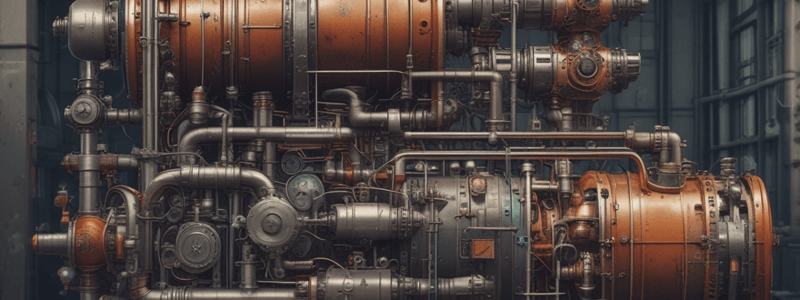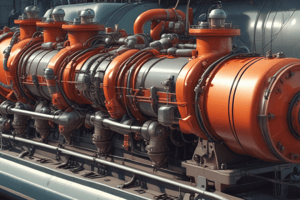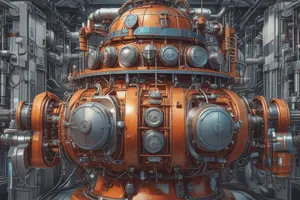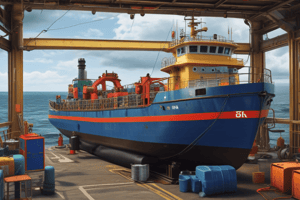Podcast
Questions and Answers
How can pressure changes that compress the air in small air bubbles affect the system?
How can pressure changes that compress the air in small air bubbles affect the system?
Produce a large amount of heat
What can 'air bubbles' and 'frothing' in the oil reservoir potentially cause?
What can 'air bubbles' and 'frothing' in the oil reservoir potentially cause?
Damage to pumps or oil boiling out of the tank
What is the importance of proper hygiene in preventing dirt contamination in the system?
What is the importance of proper hygiene in preventing dirt contamination in the system?
To prevent dirt from affecting the system
What are the consequences of water contamination in hydraulic systems?
What are the consequences of water contamination in hydraulic systems?
What actions should be taken if water contamination is suspected in the system?
What actions should be taken if water contamination is suspected in the system?
Why is it important to check the oil regularly onboard and via a laboratory in hydraulic systems?
Why is it important to check the oil regularly onboard and via a laboratory in hydraulic systems?
How can the 'compressibility' of air lead to loss of control in the system?
How can the 'compressibility' of air lead to loss of control in the system?
What measures can be taken to prevent air contamination in hydraulic systems?
What measures can be taken to prevent air contamination in hydraulic systems?
What are THREE possible contaminants in a hydraulic system?
What are THREE possible contaminants in a hydraulic system?
What are the possible causes of dirt contamination in a hydraulic system?
What are the possible causes of dirt contamination in a hydraulic system?
What are the possible causes of water contamination in a hydraulic system?
What are the possible causes of water contamination in a hydraulic system?
What are the possible causes of air contamination in a hydraulic system?
What are the possible causes of air contamination in a hydraulic system?
How are dirt contaminants prevented from affecting a hydraulic system?
How are dirt contaminants prevented from affecting a hydraulic system?
How are water contaminants prevented from affecting a hydraulic system?
How are water contaminants prevented from affecting a hydraulic system?
How are air contaminants prevented from affecting a hydraulic system?
How are air contaminants prevented from affecting a hydraulic system?
What are the effects of contaminants on a hydraulic system?
What are the effects of contaminants on a hydraulic system?
What are the five properties that enable a hydraulic fluid to fulfil its purpose?
What are the five properties that enable a hydraulic fluid to fulfil its purpose?
Explain why each of the properties stated in the previous question are important.
Explain why each of the properties stated in the previous question are important.
Explain the effect of increasing the flow rate of the hydraulic oil on the operation of the windlass.
Explain the effect of increasing the flow rate of the hydraulic oil on the operation of the windlass.
Explain the effect of changing the displacement of the hydraulic motor on the operation of the windlass.
Explain the effect of changing the displacement of the hydraulic motor on the operation of the windlass.
Explain why a full system flush and laboratory test will be needed at some stage, even if the hydraulic fluid may be used to get the system to an acceptable level for continued use.
Explain why a full system flush and laboratory test will be needed at some stage, even if the hydraulic fluid may be used to get the system to an acceptable level for continued use.
Describe the purpose of a hydraulic fluid in a system.
Describe the purpose of a hydraulic fluid in a system.
Explain how changing the displacement of the motor can affect the direction and speed control of the windlass.
Explain how changing the displacement of the motor can affect the direction and speed control of the windlass.
Describe the effect of increasing the flow rate of the hydraulic oil on the load-carrying capacity of the windlass.
Describe the effect of increasing the flow rate of the hydraulic oil on the load-carrying capacity of the windlass.
If the displacement of a hydraulic motor increases while the oil flow rate remains constant, what happens to the motor's speed and torque?
If the displacement of a hydraulic motor increases while the oil flow rate remains constant, what happens to the motor's speed and torque?
Describe the working principle of a variable delivery pump, such as the swash plate design, for controlling the speed of a hydraulic motor.
Describe the working principle of a variable delivery pump, such as the swash plate design, for controlling the speed of a hydraulic motor.
How do flow control valves, such as variable orifices, control the speed of a hydraulic motor?
How do flow control valves, such as variable orifices, control the speed of a hydraulic motor?
Explain the working principle of an air flow control valve for controlling the speed of a hydraulic motor.
Explain the working principle of an air flow control valve for controlling the speed of a hydraulic motor.
How can the use of a frequency drive for the electrical motor driving the pump help in controlling the speed of a hydraulic motor?
How can the use of a frequency drive for the electrical motor driving the pump help in controlling the speed of a hydraulic motor?
What is the typical mark distribution for a 10-mark question involving sketches and descriptions?
What is the typical mark distribution for a 10-mark question involving sketches and descriptions?
In the context of the given text, what does the term "orifice" refer to?
In the context of the given text, what does the term "orifice" refer to?
What is the purpose of the hydraulic cylinder shown in Figure Q4?
What is the purpose of the hydraulic cylinder shown in Figure Q4?
What is the purpose of check valve 'D' in the hydraulic system described?
What is the purpose of check valve 'D' in the hydraulic system described?
In the cross-over position (6), how does the fluid flow through valves 'A', 'B', and 'C'?
In the cross-over position (6), how does the fluid flow through valves 'A', 'B', and 'C'?
What is the relationship between the force exerted on the piston 'E' and the pressure and area of the cylinder?
What is the relationship between the force exerted on the piston 'E' and the pressure and area of the cylinder?
Why does the piston 'E' move to the right in the cross-over position?
Why does the piston 'E' move to the right in the cross-over position?
What is the purpose of the ports in the valves in controlling the speed of the piston 'E'?
What is the purpose of the ports in the valves in controlling the speed of the piston 'E'?
How does the fluid flow through the system when the piston 'E' moves to the left?
How does the fluid flow through the system when the piston 'E' moves to the left?
What is the purpose of valve 'B' in the hydraulic system?
What is the purpose of valve 'B' in the hydraulic system?
How does the controlled movement of the piston 'E' relate to the difference in forces on the left and right sides?
How does the controlled movement of the piston 'E' relate to the difference in forces on the left and right sides?
Flashcards are hidden until you start studying
Study Notes
Hydraulic Motor Speed Control
- If the hydraulic oil flow rate remains constant and the displacement of the motor increases, the speed will decrease, and the torque will increase.
- Conversely, if the displacement of the motor decreases, the speed will increase, and the torque will decrease.
Methods for Controlling Hydraulic Motor Speed
- Variable delivery pump: adjusting the swash plate angle alters the direction and speed of the motor due to changes in fluid flow.
- Flow control valves: variable orifices control the flow rate to the motor, affecting speed.
- Air flow control valves: pneumatically operated valves control flow rate, similar to flow control valves.
- Frequency drive for electrical motor driving the pump: allows for fine control of speed.
Hydraulic System Contamination
- Contaminants: dirt, water, and air.
- Dirt: caused by improper hygiene, poor flushing, and wear from pipework and system components.
- Water: present from condensation, leaking coolers, and contamination during system top-up.
- Air: undissolved air in the liquid can affect system components.
Preventing Contamination
- Dirt: maintain proper hygiene, use filtration during filling, and regular system checks.
- Water: check oil regularly, take immediate action to trace the source, and treat or flush the system as needed.
- Air: regular system checks, including pipework and oil analysis, to prevent air bubbles and frothing.
Hydraulic System Properties
- Five properties that enable a hydraulic fluid to fulfill its purpose:
- Viscosity
- Compressibility
- Lubricity
- Corrosion protection
- Thermal stability
- Each property is important for the fluid to function correctly and maintain system performance.
Effect of Changing Flow Rate and Displacement on a Hydraulic System
- Increasing the flow rate of the pump: meets increasing load demands, maintains pressure, and changes speed.
- Increasing the displacement of the motor: alters the direction of oil flow, offers proportional speed control, and changes speed.
Hydraulic System Components and Operation
- Hydraulic cylinder: can operate a safety barrier, affected by pressure changes and air bubbles.
- Windlass: hydraulically operated by a variable displacement motor, affected by changes in flow rate and displacement.
- Valves: 3-position valves, check valves, and pilot lines control fluid flow and pressure in the system.
Studying That Suits You
Use AI to generate personalized quizzes and flashcards to suit your learning preferences.




